May 28, 2010
Air Date: May 28, 2010
FULL SHOW
SEGMENTS
Fighting the oil in the Gulf
/ Ingrid Lobet and Jeff YoungView the page for this story
Oyster habitat has disappeared almost completely on the East Coast and by half on the Gulf Coast. Conservationists along the coasts have been working to rebuild the hard shell reefs where baby oysters settle and grow. As Living on Earth’s Ingrid Lobet reports from Mobile Bay, Alabama, shell restoration structures in the region are at risk of being coated with oil. Host Jeff Young also visits some of the richest oyster beds in the U.S. Oyster fishing supports a unique way of life on the bayous and oyster reefs could help restore the eroding wetlands. Now, the oil threatens it all. (12:10)
Cooking up a Storm- A Recipe for Disaster?
/ Bruce GellermanView the page for this story
If oil and water don’t mix, what happens when you add a hurricane? Living on Earth’s Bruce Gellerman whips up an experiment in his kitchen to see if the upcoming tropical storm season and Gulf oil gusher is a recipe for disaster. . .or dessert. (06:20)
Blocking the EPA
/ Mitra TajView the page for this story
The Environmental Protection Agency is writing new rules limiting greenhouse gas emissions from cars and industrial plants, but some members of Congress want to stop the agency from addressing climate change. Living on Earth's Mitra Taj reports on an upcoming Senate vote to revoke the EPA's authority to regulate carbon dioxide as a pollutant. (05:40)
New Leadership on Climate Change
/ Steve CurwoodView the page for this story
Costa Rican Christiana Figueres has been appointed to replace Yvo de Boer as the new Executive Secretary for the United Nations Framework Convention on Climate Change. She talks with Living on Earth’s Steve Curwood about her hopes and plans for future international climate negotiations. (06:00)
My Planet Harmony
/ Mwende HahseyView the page for this story
Living on Earth has been featuring stories every week from its sister program, Planet Harmony. The new offering follows environmental issues facing communities of color. Reporter Mwende Hahsey explains why she doesn’t consider herself to be an environmentalist but is still compelled to tell stories about the state of her environment. (02:35)
Humans and Birds: A New Pairing
View the page for this story
We see birds everyday: flying overhead, eating food scraps in cities, and singing perched in tree branches. But most of us have little relationship with these omnipresent animals. Host Jeff Young talks with naturalist Sy Montgomery about her new book that attempts to change the way that we think about birds. Her book is called, “Birdology: Adventures with a Pack of Hens, a Peck of Pigeons, Cantankerous Crows, Fierce Falcons, Hip Hop Parrots, Baby Hummingbirds, and One Murderously Big Living Dinosaur.” (10:45)
Slip-sliding Away
View the page for this story
Twenty years ago, writer Mark Seth Lender was in awe when he saw the elusive, uncommon river otter. He was caught off-guard recently when he saw another river otter at a beaver pond in Groton, Connecticut. (03:00)
This week's EarthEar selection
listen /
download
The European otter, Lutra Lutra in Northumberland, England is threatened in the UK because of wetland drainage.
Show Credits and Funders
Show Transcript
HOST: Jeff Young
GUESTS: Christiana Figueres, Sy Montgomery
REPORTERS: Mitra Taj, Ingrid Lobet, Bruce Gellerman, Mwende Hahesy
ESSAY: Mark Seth Lender
[THEME]
YOUNG: From Public Radio International—this is Living on Earth.
[THEME]
YOUNG: I’m Jeff Young. Trying to contain the ecological and political damage from the Gulf oil gusher. President Obama backs away from his proposed expansion of offshore drilling.
OBAMA: Where I was wrong was in my belief that the oil companies had their act together when it came to worst cast scenarios.
YOUNG: And the oystermen of Louisiana’s Plaquemines Parish face their own worst-case scenario.
DUPLESSIS: The magnitude of that spill ain’t no way they going to be able to stop all of it. And once it gets in the marsh you done lost the fight. You take that away, well; take away the seafood take away us—domino effect, you know.
YOUNG: The loss of a livelihood and a way of life on the bayou. Also how the coming hurricane season could affect an oiled Gulf. Those stories and more this week on Living on Earth—Stick Around!
[THEME]
ANNOUNCER: Support for Living on Earth comes from the National Science Foundation, and Stonyfield Farm.
[THEME]
Fighting the oil in the Gulf

Host Jeff Young interviews John Lopez. (Photo courtesy of Curt McClain)
YOUNG: From the Jennifer and Ted Stanley Studios in Somerville, Massachusetts—this is Living on Earth. I’m Jeff Young. After more than a month, there is, at last, hope that the Gulf oil gusher will stop. As we record this program, officials are cautiously optimistic about the "top kill" procedure to plug the leak. But the damage continues. Cleanup crews scramble to contain the oil and the president tries political damage control.
President Obama defended his handling of the crisis and put restrictions on offshore drilling: a six-month moratorium on new deepwater permits; a suspension of Arctic oil exploration; and the cancellation of leases in Virginia’s waters. It was a remarkable step back from the president’s expansion of offshore drilling announced just eight weeks ago.
OBAMA: The overall framework, which is to say, domestic oil production should be part of our overall energy mix—I think, continues to be the right one. Where I was wrong was in my belief that the oil companies had their act together when it came to worst-case scenarios.
YOUNG: An independent commission will investigate lax government oversight of drilling, and the head of the troubled Minerals Management Service resigned. And the president said the Gulf tragedy teaches a larger lesson: the country needs cleaner energy. He called on the Senate to pass the stalled energy and climate bill.
OBAMA: If nothing else this disaster should serve as a wake-up call that it is time to move forward on this legislation. It’s time to accelerate the competition with countries like China who have already realized the future lies in renewable energy. And it’s time to seize that future ourselves.
YOUNG: We also now have the first official estimate of just how much oil has spewed into the Gulf. A team of scientists with the U.S. Geological Survey says it’s somewhere between 12 and 25 thousand barrels a day. That’s two to five times more than BP first estimated, and makes this the largest oil spill in U.S. history.
It’s already been declared a "fishery disaster" in Louisiana, Mississippi and Alabama.
Tens of thousands of people in those states make their living from fish, shrimp, crabs and oysters. They supply more than 40 percent of the nation’s seafood—and 70 percent of the country’s oysters. Oysters are also vital for the ecological role they play—filtering water and forming reefs that shelter animals and the shore itself. We have two reports on the Gulf’s oysters and the people who depend on them. We start with Living on Earth’s Ingrid Lobet on the Alabama coast.
[SOUNDS OF TRUCKS HONKING, BACKING UP]
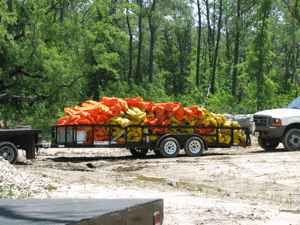
A yard used for an oyster restoration project becomes a staging ground for oil booms in Bayou La Batre, Alabama. (Photo: Ingrid Lobet)
LOBET: In a working yard on the shore of Mobile Bay, trucks loaded with neon yellow and orange boom roll in and out. This is now a spill response staging area.
[SOUNDS OF WALKING ON CRUSHED OYSTER SHELLS]
LOBET: Nearby is one of the Gulf's famous seafood canneries. And in its backyard is what might be the world's largest-ever pile of oyster shells.
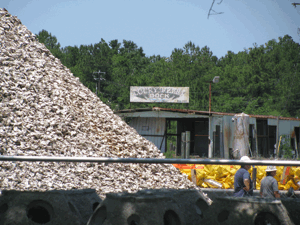
A mountain of spent oyster shells, part of a an oyster reef restoration project beside spill response workers. (Photo: Ingrid Lobet)
FINCH: We have a mountain of oyster shells. It’s huge—maybe 30, 40, 50 feet high of oyster shells, a football field long. And those oyster shells need to get back in the water, don't they?
LOBET: Bill Finch is with the Alabama Nature Conservancy. The shells need to get back into the water he says, so that baby oysters can attach to them.
FINCH: There's a lot of mud in places like Mobile Bay and sand, and oysters can't attach to mud and sand very well—they need something hard to attach to. Over tens of thousands of years oysters built their own architecture, sort of built it from the base up.
LOBET: About half of that architecture, the Gulf Coast oyster reefs, is now gone, attacked by carnivorous snails and fished out. That's what led the Nature Conservancy and other groups across 17 Gulf and eastern states to experiment with building up new reefs.
FINCH: Come up with something good for them to attach to. And the very best thing that an oyster can attach to, we've decided, is another oyster. Surprise, surprise.
LOBET: So on the days before the Deepwater Horizon oil well blew out, workers in this yard spent their time packing discarded oyster shells into special mesh bags. Then they sunk the bags offshore, building a mile of new reef. The Conservancy's oyster restoration project manager Jeff DeQuattro says everyone should care about oysters. For one thing the reefs they construct turn out to be a favorite place for fish to prowl.
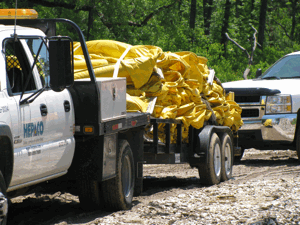
Oil booms in the truck of an environmental contractor in Bayou La Batre, Alabama. (Photo: Ingrid Lobet)
DEQUATTRO: All the Gulf species of fish, at some stage, come in contact with some form of oysters, whether it be an oyster bed, or an oyster reef. They are synonymous to coral reef.
LOBET: DeQuattro, and Marine Programs Director Judy Haner, say oysters are unappreciated filterers of water.
DEQUATTRO: Oysters filter several gallons of water a day, some say 25 gallons some say 50 gallons. It's a lot. They filter metals, they filter sediment, anything of a certain size that they can fit into their mouths.
HANER: I would say a minor sheen they could probably handle and maybe even recover from, but something that is gloppy, you know something—they are filter feeders. That is going to clog the innards if you will, and that is going to be really tough for them to save themselves from.
[SOUNDS BIRDS CALLING]
LOBET: Like Bill Finch, Haner and DeQuattro worry about the mile of new reef they've created.
HANER: This could be a big setback.
DEQUATTRO: Oysters are at pretty shallow depths, normally near shoals or near shore, so they risk being coated with oil at every stage.
[SOUNDS BIRDS CALLING, GEESE]
LOBET: If the young oysters adrift in the Gulf currents are carried into a cloud of petroleum, it will like happen just as nature is calling them to sprout a foot…to touch a rough, hard surface where they can attach and grow.

Bagged oyster shells make excellent reef for baby oyster to attach. (Photo: Ingrid Lobet)
[SOUNDS BIRDS CALLING]
YOUNG: Ingrid Lobet reporting from Alabama’s Mobile Bay. Just to the south I got on a boat for a look at the marshes of Louisiana.
[SOUNDS OF BOAT ENGINE, MAN: Hold on!]
YOUNG: In Plaquemines Parish, the oil is slowly coming ashore despite miles of booms. Some fishing grounds and oyster beds have already been shut down. This patch of Breton Sound is still clean. But scientist John Lopez fears the oil could jeopardize his group’s attempts to use oysters to protect the fragile coast.
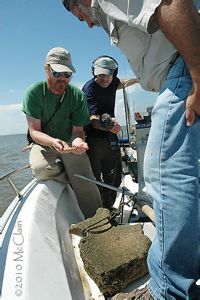
Andy Baker and John Lopez inspect part of an "oyster ball" looking for signs of growth. They hope an oyster reef will help rebuild land. They fear the oil could bring further damage. (Photo courtesy of: John Lopez)
LOPEZ: This is a location where we’re trying our oyster reef project. You’re on the edge of the marsh. Essentially, from here on out you’ve got open sound and then the Gulf of Mexico, so this little island would be one of the first areas that would be impacted if the oil did move in significant quantities into Breton Sound.
[SOUNDS OF BOAT ENGINE AND BIRDS]
YOUNG: Lopez pulls his boat up to a small patch of land where terns are nesting. He directs the coastal sustainability program for the Lake Pontchartrain Basin Foundation. He’s keeping tabs on two environmental crises out here: the oil, and the disappearing wetlands.
Louisiana loses about 25 square miles of land each year—that’s a football field every 40 minutes. Sediment from the Mississippi that once regenerated land is trapped behind the river’s levees. Canals and oil and gas pipelines cut through marsh, increasing erosion, and hurricanes rip out huge chunks. This little island was once ten acres.
LOPEZ: But about 90 percent was washed away in Katrina now right now there’s just an acre left. If something’s not done probably in just one more storm this island will be washed away entirely.
[BIRD SOUNDS, SOMETHING DROPS INTO BOAT]
YOUNG: Lopez and his assistant, Andy Baker, pull up a chunk of concrete called an oyster ball. They scrape some samples from the muck in hopes of finding the first tiny colonizers that might one day build a new reef and rebuild the marsh. Unless the oil hits.
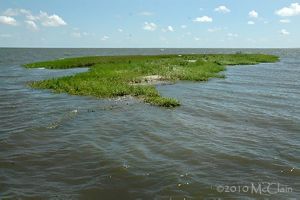
Before Katrina, this island was 10 acres; now it's just one. (Photo courtesy of Curt McClain)
BAKER: This little fragile area is one of the most vulnerable to oil. It’s really unknown if this marsh scrap can recover from oiling, or if it will be the last blow that will cause this to just completely erode into the sea.
[SOUNDS OF BOAT, OYSTER BAGS THROWN ONTO CONVEYER BELT]
YOUNG: Back at the dock in the little town of Pointe a la Hache, oyster fishermen unload hundred pound burlap sacks of oysters onto palates. These oysters are bound for the restaurants of New Orleans and beyond. Oyster fisherman Warren Duplessis says he’s lucky to still be fishing. But he knows the luck won’t hold.
DUPLESSIS: Oh yeah. Ain’t no couple of booms going to be able to hold it back. Magnitude of that spill, ain’t now way you gonna be able to stop all of it. And once it gets in the marsh you done lost the fight. I don’t know, the animals dying and then they feed on, because that’s where they breed at in the marsh. You take that away, well take away the seafood, and take away us, and domino effect, you know.
YOUNG: But, what happens to you if that happens?
DUPLESSIS: [Laughs] I guess I gotta try to find another line of work, I guess. You know. Either that or starve to death. It’ll be hard for a lot of people. It really will be. That is they whole life you know? From generation to generation. All their life know nothing but the bayou, nothing but the water. They change with the season. When it’s shrimpin’ season they’ll trawl, when it’s oyster season they fish oysters, crabbin’ they’ll crab. Whatever to make a dollar to support their family.
[MEN SHOUTING, JOKING: Tie that rope tie that rope! What’s wrong with you?]
YOUNG: A quick look around reveals something else at stake here. An African American trucker chats with a Mexican American oysterman. Men joke and swap stories in thick Cajun and Creole accents. The bloodlines are as mixed as the water, and the communities are as tight as the marsh grass roots.
DUPLESSIS: Down here this is tight-knit community, it really is. They ain’t a person that everybody don’t know everybody—who they are, what they about, where they from, they momma, they grandma, they children they nieces and nephews. That’s how close it is down here. Just pick a lane, you can say go down two miles and second lane to such and such and I could tell you who stay there, where they people at, and what they gonna be doin’ his evening. [Laughs] Just about, eh?
YOUNG: So, I guess, the big question is if oyster beds die, if shrimping is closed down for a long period time, what happens to all that?
DUPLESSIS: Well, that’s the million dollar question you know.

Host Jeff Young interviews John Lopez. (Photo courtesy of Curt McClain)
YOUNG: The uncertainty hangs thick. Nearby, Rodney Echelard sits in the shade. His face shows the work, weather and worry of 30 years on the water. He’s a deckhand now. He once captained an oyster boat until it was lost in Katrina.
ECHELARD: See when Katrina hit us that destroyed us big time. You know it took all our homes, just wiped us out. We just coming back and the oysters is coming back. Then this happened, well, going on again. We trying our best to get what we can while we can before they kill all our oysters.
YOUNG: Do you have any confidence that BP is going to make things right if oyster beds are damaged and you can’t work there anymore?
ECHELARD: I sure hope so. But my confidence is shot so far what I been seeing. I sure hope so because man, it could be a lot of years and a majority of people down here that’s all they do—you know, fish—they’ve been doing this all their life, fishing oysters. If things don’t go right, well, how can they live? Oh yeah, Bro. Hard times, dude, hard times. Right now? Yeah, it’s hard times. Yes.
Related links:
- Full transcript of the President’s remarks and May 27 press conference
- USGS flow estimates of oil coming from BP Deepwater Horizon accident site
- Click here to read the Department Of Interior’s report on increased safety measures
- Click here to read the Department Of Interior’s report on MMS.
[MUSIC: Ray Charles “Hard Times” from Pure Genius: The Complete Atlantic Recordings 1952 – 1960 (Rhino – Atlantic 2005)]
YOUNG: Just ahead—the Gulf Coast clean up faces another challenge—hurricane season is just days away. Keep listening to Living on Earth!
Cooking up a Storm- A Recipe for Disaster?
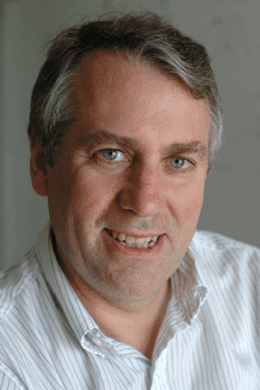
Atmospheric Scientist Kerry Emanuel. (Photo courtesy of: Donna Coveney MIT News Office)
YOUNG: It’s Living on Earth, I’m Jeff Young. The Atlantic hurricane season begins June first and forecasters predict an above-average season with 23 named storms, including 14 hurricanes. All the ingredients are there: Atlantic sea-surface temperatures are at near record highs and Pacific waters are cooler following last year’s el Nino.
But this year there are two new ingredients in the mix: millions of gallons of oil and thousands of pounds of chemical dispersants swirling in the Gulf of Mexico. As Living on Earth’s Bruce Gellerman reports this could be a recipe for even greater environmental disaster—or perhaps—a perfect storm that ends up helping.
[SOUNDS OF INDOOR POOL]
GELLERMAN: You know how you get a chill when you come out of a swimming pool.
[SOUNDS OF CLIMBING OUT OF POOL]
GELLERMAN: That’s because of evaporation, and evaporation is the same process that’s the source of energy that drives hurricanes. In summer, solar energy heats the tropical seas. The warm water evaporates and cools, and the energy flows from sea to sky, spawning storms. Kerry Emanuel, professor of atmospheric science at MIT, wanted to study this process, so he built a mini Gulf of Mexico.

Atmospheric Scientist Kerry Emanuel. (Photo courtesy of: Donna Coveney MIT News Office)
EMANUEL: Yes we did, some years ago in a laboratory. We built a laboratory apparatus to study how heat is transferred from the ocean to the atmosphere when wind blowing at hurricane force. And we were interested in this because that heat flow is what powers hurricanes.
GELLERMAN: When the experiment was just about finished Professor Emanuel asked himself a question: What would happen if he added oil to the water? Would the slick on the surface absorb more solar energy and increase the power of a hurricane? Or could an oil spill block evaporation and stall the formation of a storm?
EMANUEL: There’s work going back to the 1960’s that suggested that we could put oil on troubled waters and thereby slow down a hurricane.
GELLERMAN: Emanuel’s team set out to create an oil spill in their lab and test if the slick could stop a storm in its tracks.
EMANUEL: And so we tried various substances: olive oils, fish oils, you know various kinds of organic oils. And they do curtail evaporation at low wind speed but once the winds really start to blow the films start to break up and cease to have an effect.
GELLERMAN: In the lab the oil slick didn’t disrupt hurricane formation, but the experiment did show that when it blows 74 miles an hour—the minimum speed for a hurricane - the churning action of wind and waves speeds up the breakdown of the oil, which is good if you have a giant gusher, like the one now polluting the Gulf. What researcher Kerry Emanuel didn’t test was the effect of an ingredient BP is adding to the disastrous Deepwater Horizon spill: dispersants. So my kids and I tried a simple experiment of our own:
GELLERMAN: Ok so here we are in our laboratory better known as our kitchen. And let’s see, here is our…
ANDRE: Blender.

Anya and Andre cook up an experiment in the Gellerman Kitchen. (Photo: Bruce Gellerman)
GELLERMAN: Ok, we’ll use that as our ocean. And here is our:
ANYA: Olive oil!
GELLERMAN: That will be our oil spill.
ANYA: That’s so cool.
GELLERMAN: And it’s all coming to the surface…and you take our surfactant.
ANYA: Dishwasher soap.
GELLERMAN: A little squish, and we’ll add a hurricane.
[SOUNDS OF BLENDER]
ANYA: Oh my gosh! [Laughs] Wow.
ANDRE: It looks like milk.
ANYA: Yeah it does. It looks like a milkshake. Is that what happens when it like mixes together?
GELLERMAN: Under certain conditions yes. It’s what happened 21 years ago when the Exxon Valdez dumped 11 million gallons of crude into Alaska’s Prince William Sound. Dispersants were used. Two days later a blustery storm just under hurricane speed blew in—blending: sea, oil, and chemicals. It was a recipe for a disaster.
PEGAU: The storm emulsified the oil so what it did was make it a real foamy mess.
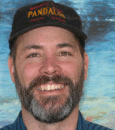
Scott Pegau is Research Program Manager with the Oil Spill Recovery Institute. Credit; OSRI
GELLERMAN: Scott Pegau is research program manager for the Oil Spill Recovery Institute in Cordova Alaska. The institute funds research on Arctic and sub-Arctic oil spills in marine environments. Pegau says in the aftermath of Valdez scientists came up with a new technical term for the stuff whipped by the storm. And the name, like the goo, stuck: Mousse.
PEGAU: Mousse, as in like the dessert, but not as nice.
GELLERMAN: What was the effect of having this mousse?
PEGAU: The mousse is more difficult to clean up. You don’t have a lot of your options. So, you can’t burn it. You have to use different mechanical equipment to help pick it up because it has a different viscosity to it. But with the Exxon Valdez you had so much oil come out at that one time it was going to be hard one way or another.
GELLERMAN: Scientists don’t expect a storm will create as much oily mousse from BP’s well as the Valdez disaster. The Gulf is larger, the oil is lighter, and the slick thinner and more spread out. The situation today is actually closer to what happened in 1979 when Mexico’s Ixtoc One rig blew up off the coast of the Yucatan, dumping 140 million gallons of oil into the Gulf.
The crude coated the Texas coast. And two months later a tropical storm blew through. But to the surprise of many scientists it cleaned up much of the oil that washed ashore, though it also created tar reefs off shore that would break into pieces in later storms coating beaches with goo for years to come.
A hurricane will certainly disrupt the Deepwater Horizon clean-up effort and the fear now is that a storm surge—driven by a hurricane’s intense winds—could drive a wave of oily water far inland. Professor Piers Chapman, head of the department of oceanography at Texas A&M recalls the surge accompanying Hurricane Rita in 2005:
CHAPMAN: The water from Rita ended up pretty much on I-10, which was 20 to 30 miles inland.
GELLERMAN: This is supposed to be a pretty active hurricane season?
CHAPMAN: Yes, that’s the worry.
GELLERMAN: Every tropical storm is unique and unpredictable, and millions of gallons of oil and chemical dispersants above and below the Gulf add to the complexity. Making this year’s hurricane season a giant, closely watched experiment of enormous importance. For Living on Earth I’m Bruce Gellerman.
[MUSIC: Monty Alexander “Hurricane” from Goin Yard (Telarc Records 2001)]
Blocking the EPA
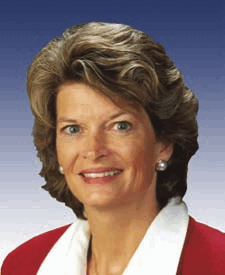
Senator Lisa Murkowski
YOUNG: The Environmental Protection Agency recently announced tough new emissions standards for cars and trucks—the country’s first limits on greenhouse gases from vehicles.
And early next year the EPA will ask big industrial polluters to cut back on C02. These moves come thanks to the EPA’s new authority to regulate greenhouse gases. But that upsets some members of Congress who think the agency has no business regulating its way to climate change policy. Living on Earth’s Mitra Taj reports.
TAJ: In the late 1990s, environmental advocate Joe Mendelson was thinking about how to get the government to take action on climate change. As a lawyer for the Sierra Club, he saw potential in the Clean Air Act:
MENDELSON: The definition of what a pollutant is under the Clean Air Act —is very broad. It’s basically things that are emitted into the air and harm public health and welfare.
TAJ: Though the Environmental Protection Agency was using the Clean Air Act to limit pollutants like lead and carbon monoxide, it was reluctant to put carbon dioxide into the same category. The Bush administration said the agency simply didn’t have the authority to curb emissions of greenhouse gases. States and environmental groups sued, and the case eventually landed in the United States Supreme Court, where Mendelson served as co-counsel.
MENDELSON: At one point actually, some spittle from Justice Bryar landed on my notes in front of me, and I looked around and I realized: ‘Wow, I went to law school to be an environmental attorney and now you’re in the Supreme Court on climate change.’ So I can’t say I expected it but once we started moving forward I saw the path you could go down.
TAJ: The path led to the Court’s controversial 2007 ruling, telling the EPA it can regulate greenhouse gas emissions. Then to the Obama EPA decision to use that authority. It first enacted tougher standards for vehicle emissions, and soon will do the same for big industrial polluters. But Republican Senator Lisa Murkowski wants to put a stop to it all.
MURKOWSKI: I would like to think that we can put the brakes on EPA now as they’re moving forward in implementing regulations under the Clean Air Act. I don’t think they, as a regulatory agency, should be the one that puts in place climate policy.

Senator Lisa Murkowski
TAJ: The Alaskan Senator wants Congress to strip EPA’s new authority using a little-used process called the Congressional Review Act. No filibusters allowed—that means she only needs 51 votes instead of 60 to get it passed. She already has 41, but many analysts say getting it through the Senate will be tough; Getting it through the House tougher still; and getting the president to sign it into law—unlikely. Joe Mendelson now directs global warming policy for the National Wildlife Federation.
MENDELSON: I’m heartened by the fact that I don’t think it’s going to become law. However it is a symbolic vote as to what the Senate thinks about climate change. For the Senate to support the Murkowski amendment would be a real step back in denying climate science. And I think that’s a vote that Senators do not want to be on the wrong side of history on.
TAJ: But that’s not how everyone sees it. Myron Ebell is director of energy and global warming policy at the conservative think-tank, the Competitive Enterprise Institute.
EBELL: The Murkowski resolution is something that people should support—even if they think global warming is a big problem. Now we don’t think global warming is a big problem, but even if you do you should agree that the Clean Air Act is about the worst possible way that you could figure out to regulate carbon dioxide emissions.
TAJ: He says the free market should lead the way, and that EPA action will only raise prices and suppress technological innovations that could lead to emissions reductions. The Obama administration says it’s better to legislate a solution than to mandate one. A law passed by Congress would build more consensus, have broader reach, and be more likely to survive following administrations. But the Senate has yet to act.
Lindsey Graham used to be the key Republican co-sponsor of the Kerry-Lieberman bill to cap greenhouse gas emissions. It puts a price on carbon and takes away EPA’s ability to use the Clean Air Act to reduce some industrial emissions. Senator Graham’s no longer promotes the bill, but he is one of 41 cosponsors of Murkowski’s resolution.
GRAHAM: I’m going to vote to preempt the EPA with the understanding that Congress should eventually and systematically regulate carbon pollution.
TAJ: Graham says the Gulf spill has made it tougher to sell the Kerry-Lieberman bill’s key tradeoff—an expansion of offshore oil drilling. He said smaller versions of an energy-climate bill could be the way forward.
GRAHAM: There’s some things we can do on nuclear power; there are some things we can do on the alternative energy side that would make it easier for our country to start creating technologies before China owns the whole alternative energy economy, but I don’t see 60 votes right now for capping carbon and expanding offshore drilling.
TAJ: One no vote would likely come from Lisa Murkowski.
MURKOWSKI: I don’t think that the EPA preemption language in Kerry-Lieberman is adequate. So to suggest that even if I did like the EPA preemption language in Kerry-Lieberman that I would somehow support the bill ignores the flaws in the rest of the bill.
TAJ: Senator Murkowski’s proposal is scheduled for a vote June tenth; the Kerry-Lieberman climate bill could hit the floor later this summer. In the meantime, the EPA is gearing up to require big power plants, factories and refineries to reduce their greenhouse gas emissions starting January of next year. For Living on Earth, I’m Mitra Taj in Washington.
Related links:
- For more of Murkowki's view's on the EPA's authority, click here.
- For more from opponents of the resolution, click here.
- Click here for more about the EPA's endangerment finding.
New Leadership on Climate Change
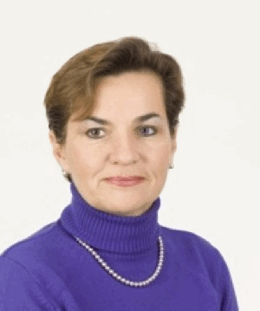
Christiana Figures will be the first person from the developing world to serve as the Executive Secretary of the UNFCCC.
YOUNG: The United Nations has announced a new Executive Secretary for its Framework Convention on Climate Change—that’s the body charged with negotiating a global treaty to reduce greenhouse gases.
Christiana Figueres of Costa Rica will succeed current secretary Yvo de Boer. She has a lengthy resume of international work related to climate change. And Figueres comes from a long line of public servants: both her brother and father served as president of Costa Rica and her mother was a member of Costa Rica’s Congress. Living on Earth’s Steve Curwood telephoned Ms. Figueres to ask about her tough new job.
FIGUERES: Hi, how are you? Thank you for your invitation today.
CURWOOD: Well, and congratulations on your appointment.
FIGUERES: Well thank you!
CURWOOD: But did you ever think, be careful of what you wish for? This is not the world’s easiest job.
FIGUERES: It’s not the world’s easiest, but it’s definitely the world’s most inspiring. I am delighted, and I’m very much looking forward to it.
CURWOOD: How’d you get interested in climate?
FIGUERES: I got interested in climate in the early ‘90s because Costa Rica had already taken a very decided world leadership role in taking climate change as a national goal and that was actually, to be honest, under my brother’s presidency was his vision. And I was inspired by that and I thought, well, if Costa Rica can do it, it is possible that other countries in Latin America could also benefit in this way.
And I took the lessons learned from Costa Rica, found a international NGO who’s purpose it was to support governments in Latin America to get more and more involved in the climate convention and begin to adopt more climate-friendly policies. And I dedicated quite a few years of my life to that NGO.
CURWOOD: People say you were selected because you have a great reputation of being a negotiator, a conciliator who brings people together. How much of that do you see as your personal strength?
FIGUERES: Absolutely critical. Absolutely critical, I’ve been really honored to have done that for quite a few years. On specific subtopics, this is the first time in which I will have the honor and the task of doing that conciliation for the entire breadth of topics. But it is clear that we are at a point in which conciliation and identification of common ground among the different parties is very critical in order for us to move forward.

Christiana Figures will be the first person from the developing world to serve as the Executive Secretary of the UNFCCC.
CURWOOD: How important is it that you’re the first American—Latin American, yes, but also very conversant with American culture, too - to head the UN Climate Convention?
FIGUERES: I would say what is very, very important is it’s the first citizen of the developing world that occupies this post.
We have had three executive secretaries—the first, Michael Zammit Cutajar from Malta; the second, Joke Waller-Hunter from Holland; the third, current executive secretary, Yvo De Boer, also from Holland—so first time this is in the hands of the developing world, and I think that’s actually quite symbolic and represents the much greater role that the developing world is taking in the climate negotiations.
CURWOOD: I’m wondering if there can be a UN climate agreement without the U.S. passing a climate bill. Indeed, can you even have a very good meeting in Cancun in—what, beginning of December of this year—without a U.S. climate bill?
FIGUERES: If the U.S. manages to have an approved climate bill by the time that we all go to Cancun, it will obviously be a boost to the negotiations. However, if that legislation is still underway and needs to be further worked on next year we can still have a successful meeting in Cancun.
What we’re focusing on—what countries have chosen to focus on in Cancun—is the very concrete delivery of the building blocks of a future agreement including fast-track financing, a structure to acknowledge the transfer and capacity building, a concrete way in which to address reduction of emissions from deforestation and degradation, and—certainly very, very importantly for the most vulnerable countries—a very structured way to address adaptation. So all of these represent an opportunity where the United States can participate even in the absence of an overall, national legislation.
CURWOOD: Now, in Copenhagen the promise was made that there’d be some 100 billion dollars in climate finance. Now what’s it going to take to deliver that?
FIGUERES: The pledge under the Copenhagen accord is for industrialized countries to provide ten billion dollars a year for this year, for the next year, and for the year 2012, making up a total of 30 billion that are under the classification of fast start financing.
After that the Copenhagen accord aspires to an availability of 100 billion dollars by the year 2020, and countries will have to budget in an incremental fashion so we will gradually be moving up to that.
CURWOOD: How do you build trust and credibility into the process?
FIGUERES: One of the things that I think is most urgent there to build trust is to begin to give proof of a willingness to move forward and to act. And in that sense Cancun acts as a very, very important step in the trust building process, in which I see that in Cancun we may be able to put on the table already some of the element that were identified in Copenhagen.
All of these that are currently pledges and good intentions on paper really need to be brought into life.
CURWOOD: Well, I look forward to seeing you in Cancun.
FIGUERES: Thank you very much, so do I!
CURWOOD: Christiana Figueres is the incoming executive secretary at the United Nations Framework Convention on Climate Change. Thank you so much.
FIGUERES: Thank you.
Related links:
- Read the press release: Christiana Figueres Appointed New UNFCCC Executive Secretary
- UNFCCC Home Page
- Click here for more on Christiana Figueres
- Click here for an extended interview with host Steve Curwood and Christiana Figueres.
[MUSIC: Erik Truffaz “Sweet mercy” from The Mask (EMI 2000)]
YOUNG: You can hear Steve Curwood’s full interview with Christiana Figueres on our website, loe dot org—and check out our new Facebook page, it’s PRI’s Living on Earth.
[MUSIC CONTINUES]
YOUNG: Coming up: what author Sy Montgomery learned from the flock in her back yard and a rare bird half way around the world. Birdology—just ahead on Living on Earth.
ANNOUNCER: Support for the environmental health desk at Living on Earth comes from The Cedar Tree Foundation. Support also comes from the Richard and Rhoda Goldman Fund for coverage of population and the environment. And from Gilman Ordway for coverage of conservation and environmental change. This is Living on Earth on PRI – Public Radio International.
My Planet Harmony
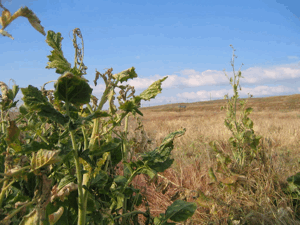
The arid soil of Central California is a haven for bacterial spores that cause respiratory problems. (Photo courtesy of: Mwende Hahsey)
YOUNG: It’s Living on Earth, I’m Jeff Young. For the past month we’ve been featuring stories from our new online offering, Planet Harmony. We've heard reports from all over the country about communities often under-represented in environmental decision-making. Well, today, one of our Planet Harmony reporters has some thoughts on the importance of bringing more voices to environmental conversation.
HAHESY: Hey this is Mwende Hahesy and I’m sitting here next to the Pacific Ocean on Westcliffe Beach, in Santa Cruz, California. I don’t consider myself an environmentalist; it’s just the state of the environment has a lot to do with the health of my family and friends. The health of a community can be measured through the health of its environment. And to me, no other community lives up to this more than the one I grew up in.

Mwende Hahsey reports for Planet Harmony from her new home in Santa Cruz. (Photo courtesy of: Mwende Hahsey)
I was raised in the San Joaquin Valley in Central California. When you drive through the Valley, as we like to call it, you pass through an endless succession of alfalfa fields, orange trees and dairies. It’s a pastoral piece of Americana. On the flip side, the Valley has some of the highest rates of obesity and childhood asthma in the country. And these rates are even worse for people of color. So then I have to take a step back and remind myself to give things a second look.
When I was a kid, I had severe asthma. But I was hardly a special case. I remember my daily midday asthma treatment at school. I would stand in line outside the nurse’s office and wait with at few other kids who were almost exclusively Latino.

The arid soil of Central California is a haven for bacterial spores that cause respiratory problems. (Photo courtesy of: Mwende Hahsey)
We never really thought much of it; this was simply a fact of life. But the older I got, the more this general acceptance bugged me. The Valley was my home but it made me sick. Now that I’m older I see all the signs around me: the thick layer of smog on the horizon and the crop dusters that drop pesticides on fields near housing developments. Valley residents are unhealthy because of these very things. Why wasn’t anyone angry?
Planet Harmony has created a space. Now we can follow underrepresented communities’ struggles and accomplishments in environmental and health issues across the country and the globe.
YOUNG: Mwende Hahesy reports for Planet Harmony. Planet Harmony welcomes all and pays special attention to issues affecting communities of color. Check out more from Mwende and contribute your own thoughts, ideas and stories at My Planet Harmony dot com. That's my planet harmony dot com.
Related link:
Hear more from Mwende and contribute your own thoughts
[MUSIC: Medeski, Martin & Wood “Free Go Lily (Remix) from Remixolarians (Indirecto 2009)]
Humans and Birds: A New Pairing
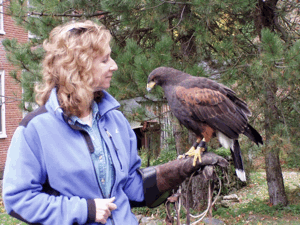
Sy Montogomery learning falconery. (Photo courtesy of: Selinda Chiquoine)
YOUNG: Author and Living on Earth contributor Sy Montgomery wants to challenge the way we relate to the other species we live with here on Earth, especially some of the ones we most take for granted—birds.
Her new book “Birdology” is an ambitious study of the avian world, and its subtitle gives a hint of just how wide-ranging the book is: it’s “Adventures with a pack of hens, a peck of pigeons, cantankerous crows, fierce falcons, hip hop parrots, baby hummingbirds, and one murderously big living dinosaur.” Sy Montgomery, welcome back to Living on Earth.
MONTGOMERY: Thanks for having me.
YOUNG: You went pretty far a field in your research—all the way to the other side of the planet in search of what you call the “dinosaur bird,” the cassowary.

The dinosaur bird: the Cassowary. (Photo courtesy of Jim Rowan)
MONTGOMERY: Yes, the cassowary! This is a bird who weighs 150 pounds, he’s got a tall helmet of bone on his head, he’s got these amazing feet equipped with slashing toenails—they look more like dinosaurs than many dinosaurs did. And so the chance to see one of these in the wild was really worth a great deal of effort. [Laughs]
YOUNG: And you kept trying and trying, going to this place and that. They’re fairly elusive. Finally you had your moment.
MONTGOMERY: That’s right. That’s right. It was actually the last day I was in Australia, and I thought, ‘Oh, no, I’m going to have to go home and I will have heard it, but never seen it.’
And as I sat there on a bench, just waiting, that was when the bird slipped out of the forest, stepping as if through a crack in time, and this man-tall, 150-pound bird steps out of the forest right in front of me. So close that I could see his orange eyes, and even the eyelashes fringing it. I could see the red waddles swaying on the blue neck. I could see how the cask, the helmet of bone, curved slightly to one side. I could see the long, slashing toenail on the foot.
And of course, you know, the bird had to have seen me—here I am 125 pounds with yellow hair sitting right there, but he never looked at me. It was like I didn’t exist. It was as if I had traveled back into time, and there weren’t any people. I finally had a wish I’d treasured since I was a little kid playing with my plastic dinosaurs. I had a dinosaur right in front of me.
YOUNG: The cassowary’s call—you describe it as something that you feel in your chest almost more than you hear?
MONTGOMERY: Yes. People who have heard cassowary calls in the wild often think they’re in an earthquake, because it’s this deep, thunderous, resonate call. Did you see “Jurassic Park”?
YOUNG: Mm hmm.
MONTGOMERY: There’s a point in “Jurassic Park” where the dinosaurs are coming—
YOUNG: You see the water vibrating in the cup and things like that?
MONTGOMERY: Exactly, that’s what this sounds like. And in fact it probably is very similar to the kinds of calls that dinosaurs made because there are plenty of dinosaurs, particularly the ones we call the hadrosaurs, or the duck-billed dinosaurs, that had those tall, helmets of bone on the head. And it’s this deep call that travels a long way in the wet rainforest.
YOUNG: Well, it’s a fascinating glimpse into that bird and also the community that has embraced that bird. Everywhere you go, you find people who have these really special relationships with birds. I guess that’s part of your quest here is to better understand not just birds, but how bird and people really relate?
MONTGOMERY: Exactly. In fact, all of my books really are looking at the relationships between people and the rest of animate creation. Many of us go through our whole day interacting only with one species. And while it’s true that humans are pretty great and, you know, I married one, my whole family isn’t made up of just one species—I’ve got several species in my family, and it’s important to me to have relationships with members of other species. Otherwise, how can we feel at home on this earth?

Sy Montogomery learning falconery. (Photo courtesy of: Selinda Chiquoine)
YOUNG: You know, I really liked your chapter on falconry and birds of prey. The fierceness that you write about is so evident in these animals it’s striking—they are pure. And I really like that you strongly identified with that, so much so that you had to learn falconry.
MONTGOMERY: Yes, it’s because I love birds, of course, but falconry is venery. I always thought venery was one of the seven deadly sins, but venery is hunting. And I’m definitely not a hunter. I mean I’m a vegetarian! I won’t eat a hamburger. So—
YOUNG: You had to get over that in a hurry if you’re going to be—
MONTGOMERY: [Laughs] Oh my Gosh!
YOUNG: Wait a minute, you raise chickens, and here you are, you’re going to be feeding these hawks baby chicks, little chicks, is that right?
MONTGOMERY: Yes, and I have raised baby chicks by keeping them in my sweater all day. I mean, it was rough, but I wanted this so badly, to touch that fierceness to touch the pureness of that living in the moment, that instinctiveness, that pure wildness. I really wanted to go there.
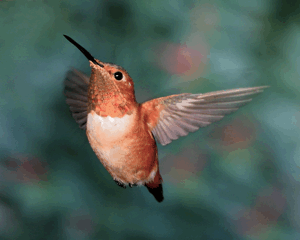
An Allen's Hummingbird. (Photo courtesy of J. Turner MD/VIREO)
And the only way to really go there is to become a hawk’s hunting partner because hunting is what they want. The term in falconry is called “yarak” and it names that intense desire, the desire above all else to hunt, to chase, to catch and to be a part of that is thrilling beyond measure.
YOUNG: I got the feeling at several points in the book that you felt this temptation, as we all do, to project human qualities onto animals that we identify with. But in this chapter on the hawks I got the feeling that you decided it’s best to just appreciate these animals for what they are.
MONTGOMERY: Well, you know, what we call human qualities aren’t just shared by humans unless you think we arose bonobo. Evolution tells us that we share 40 percent of our DNA with a daisy and just because we as humans can think and feel it doesn’t mean that nobody else can think and feel.
But in some case I’m certain that birds can in fact think and feel much as we do because there’s some bird that can tell us this—Parrots who talk and speak meaningfully. But in the hawks I was concentrating on an aspect of birds that isn’t necessarily shared with humans, and I’m so interested throughout this book and exploring the ways that we are both like and unlike birds. I’m fascinated by both their sameness and their otherness. And in the hawk chapter I’m very much exploring that otherness.
YOUNG: You went really far a field to do some of this work, but a lot of it was motivated by the birds right there in your backyard. You develop a relationship with your chickens I think not a lot of people who keep chickens do. They’re almost members of the family.
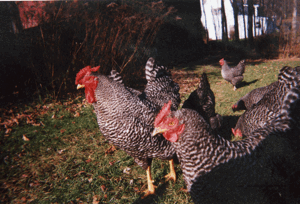
Dominique Chickens. (Photo courtesy of Howard Mansfield)
MONTGOMERY: Oh, they certainly are. They come in the mail as babies, and I keep them the first few weeks in my office where I write. And they grow up sitting on my shoulders, sitting in my lap. And they adopt me as an honorary chicken, so this gives me a great view into the chicken universe.
YOUNG: Raising chickens, especially now, increasingly in urban settings—it’s kind of a hot thing! Why do you think that’s taking off?
MONTGOMERY: I think it’s starts with this idea of self-sufficiency, but then something else happens that maybe people didn’t initially bargain for. And that is that they fall in love with their chickens. They realize, these are smart animals, these are not stupid automatons; each one has an individual personality; they make these lovely sounds, they’re beautiful, they’re graceful; and they know us. It’s now known from laboratory experiments that the average chicken can recognize 100 other individuals.
And they look at each other and know who you are pretty much the way we do, by looking at the face. They’re really great. And each one is extremely individualistic. Some are bold and brassy, some are shy. Some are real smart. And you can’t really spend time with chickens without realizing that everything we know about chickens—like that they’re stupid, filthy, automatons—is completely wrong. They’re so surprising; you can’t help but fall in love.
YOUNG: A chicken is a bird that has such a special relationship with people—what have you learned about how we and they affect each other?
MONTGOMERY: Well, unfortunately, most peoples’ relationship with chicken is of a culinary nature. [Laughs] And I was very surprised to learn that the humane laws that cover—and they aren’t strong enough for mammals, but they do exist for mammals who are raised for food—they do not exist for birds.
And the last place in the world that you should keep a chicken is cooped up in a place where they can’t have meaningful relationships with other chickens. That’s everything to a chicken. You hear about the pecking order—the pecking order is about order, it’s not about pecking, but it’s really important to know who you are in the flock. They’re very social creatures.
YOUNG: What do you think is the most surprising thing you’ve learned about birds in the course of researching and writing this book?
MONTGOMERY: The most unwelcome surprise was the rate at which birds are declining, and this was shock: one out of every eight bird species is in decline, worldwide. And in North America, a quarter of our birds have been declining since 1970. It’s worse on some continents: in Europe it’s nearly half the common birds that are in decline, including the famous nightingale.
I suppose it shouldn’t be all that surprising because we know exactly what’s causing the problem, it’s the usual suspects—it’s overpopulation, it’s deforestation, it’s pollution, it’s global climate change. According to Bird Life International, global climate change is the number one reason that birds are in decline around the world. So, we know why it is and we know how to fix it. And it’s my hope that we will let the birds inspire us and give us the courage to do what we know needs doing to make this world a fit place for birds and beasts.
YOUNG: Sy Montgomery, the book is Birdology – thank you so much.
MONTGOMERY: Thank you for having me back on.
Related link:
Birdology Homepage
[MUSIC: Charlie Parker “Bird Of Paradise” from The Best Of The Dial Years (Stardust Records 2005)]
Slip-sliding Away

(Courtesy of: Mark Seth Lender/Salt Marsh Diary)
YOUNG: River Otters are not common in southern New England. Writer Mark Seth Lender had not seen one in 20 years. The only sure way to find them is when they find you. As Mark stood on the edge of a small pond in Groton Connecticut, that’s just what happened.
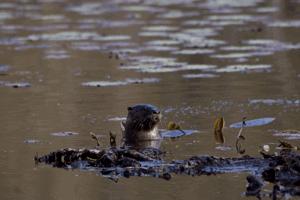
(Photo: Mark Seth Lender/Salt Marsh Diary)
LENDER: On the far side of the pond, bubbles Braille the surface, cerulean blue, soft as morning stars. Half light, the air is still, the lilies rustle. Their posted buds stirred by a breeze of water sway like channel markers. There just off shore someone breaking fast, leisurely. Jaws worked in whisper, reaching across the silence there. Then rolls and dips and disappears.

(Photo: Mark Seth Lender/Salt Marsh Diary)
A beaver lodge stands nearby, they built this pond, but that was no beaver. The texture of its fur, the shape and the way it moved. The smoothness of the dive and how the surface rose and closed—a navel of water and what it brings to mind. That surface, opaque as skin, blind to what lies beneath. Patience! Patience!

(Photo: Mark Seth Lender/Salt Marsh Diary)
The crease of a wake, grainy light, the water speaks. A head appears, oiled, sleek, coat like silk all umber and burnt ochre. Whiskers, dark eyes, fearless that broad, boy cat face so close, and my heart leaps—I, too, am fearless, I am soaring. I see what I was sure I would never see again. And now again.
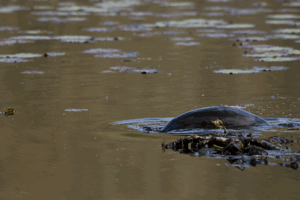
(Photo: Mark Seth Lender/Salt Marsh Diary)
The river otter alone in having had his long look turns away. Now head, now back, now tail slipping beneath. Some yards off he reappears, looks again, dives again, resurfaces. This time he has a bullfrog. It dangles from his mouth as if forgotten. His gaze still fixed on me, more intense than curious as if he has as much to tell as to learn. For the last time he slides below leaving a silence so profound, neither speech nor written word can break it.
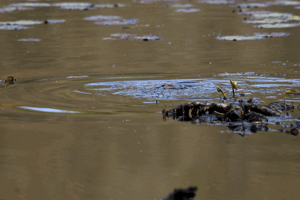
(Photo: Mark Seth Lender/Salt Marsh Diary)
Related link:
Salt Marsh Diary
[MUSIC: Ralph Towner/Paolo Fresu “Sacred Place” from Chiaroscuro (ECM Records 2010)]
YOUNG: Mark Seth Lender writes the syndicated column “Salt Marsh Diary.” To see his photographs of the river otter and find out more, go to our website l-o-e dot org.
[MUSIC CONTINUES]
[WHISTLES AND SQUAKS OF WETLAND ANIMALS]
YOUNG: We leave you this week in the wetlands of Northumberland, England.
[WHISTLES AND SQUAKS OF WETLAND ANIMALS]
YOUNG: These high-pitched squeaks might sound like birds but they’re actually the calls of a pair of otters. The European Otter, or Lutra lutra, is an endangered species in Britain, mainly due to wetland drainage and water pollution. This recording is on the CD “Vanishing Wildlife” and comes to us courtesy of the British Library and the University of Chicago Press.
[SOUNDS OF OTTERS CONTINUE]
YOUNG: Living on Earth is produced by the World Media Foundation. Our crew includes Bobby Bascomb, Eileen Bolinsky, Bruce Gellerman, Ingrid Lobet, Helen Palmer, Jessica Ilyse Smith, Ike Sriskandarajah, and Mitra Taj, with help from Sarah Calkins, and Sammy Sousa. This week we bid a grateful – if glum – farewell to our wonderful interns, Emily Guerin and Bridget Macdonald. We wish you both the very best of luck! Jeff Turton is our technical director. Alison Lirish Dean composed our themes. Steve Curwood is our executive producer. You can find us anytime at LOE dot org – and check out our new Facebook page – PRI’s living on earth. I’m Jeff Young. Thanks for listening.
ANNOUNCER: Funding for Living on Earth comes from the National Science Foundation, supporting coverage of emerging science. And Stonyfield Farm, organic yogurt and smoothies. Stonyfield pays its farmers not to use artificial growth hormones on their cows. Details at Stonyfield dot com. Support also comes from you our listeners, The Ford Foundation, The Town Creek Foundation, The Oak Foundation, supporting coverage of climate change and marine issues. The Bill and Melinda Gates Foundation, dedicated to the idea that all people deserve a chance to lead a healthy, productive life. Information at Gates Foundation dot org. And Pax World Mutual Funds, integrating environmental, social and governance factors into investment analysis and decision making, on the Web at Pax World dot com. Pax World – for tomorrow.
Living on Earth wants to hear from you!
Living on Earth
62 Calef Highway, Suite 212
Lee, NH 03861
Telephone: 617-287-4121
E-mail: comments@loe.org
Newsletter [Click here]
Donate to Living on Earth!
Living on Earth is an independent media program and relies entirely on contributions from listeners and institutions supporting public service. Please donate now to preserve an independent environmental voice.
NewsletterLiving on Earth offers a weekly delivery of the show's rundown to your mailbox. Sign up for our newsletter today!
 Sailors For The Sea: Be the change you want to sea.
Sailors For The Sea: Be the change you want to sea.
 The Grantham Foundation for the Protection of the Environment: Committed to protecting and improving the health of the global environment.
The Grantham Foundation for the Protection of the Environment: Committed to protecting and improving the health of the global environment.
 Contribute to Living on Earth and receive, as our gift to you, an archival print of one of Mark Seth Lender's extraordinary wildlife photographs. Follow the link to see Mark's current collection of photographs.
Contribute to Living on Earth and receive, as our gift to you, an archival print of one of Mark Seth Lender's extraordinary wildlife photographs. Follow the link to see Mark's current collection of photographs.
 Buy a signed copy of Mark Seth Lender's book Smeagull the Seagull & support Living on Earth
Buy a signed copy of Mark Seth Lender's book Smeagull the Seagull & support Living on Earth

